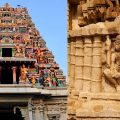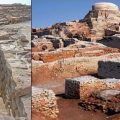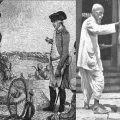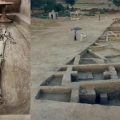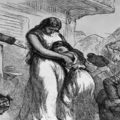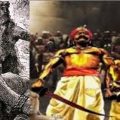Aryan Migration Theory: Fraud and Confusion Created to Justify British Rule in India
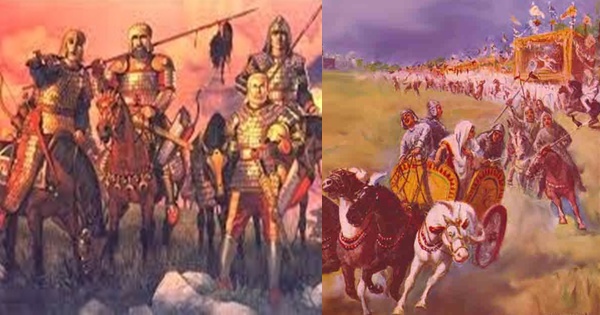
To justify British rule in India, it was necessary to create a theory that all Indians also migrated from outside in past and ruled India. British rule was the latest version. They could not find any evidence in ancient Indian texts. Even the Greek Historians in time of Alexander wrote that India is only country where all persons are indigenous. As India was self sufficient in food and minerals, it never attacked any nation in past 15,000 years. From figure of 15,000 years, one zero was dropped and 1500 BC was declared as start of Vedic civilization of Aryans who migrated from north west.
In absence of any evidence, digging was done in 1920 in two well known historic sites in northwest India as ruins due to attack of Janamejaya on Naga Kingdom and Indika of Megasthenese was suitably changed by McCrindle in 1927. When one clerk R D Bannerji wrote that evidence of Vedic civilization was found in Indus valley, he was dismissed from service. All theories were created almost opposite to description in texts. Unread script of Indus valley was called most authentic than Vedas and Purāṇas being read since more than 10,000 years. Indra was called ruler of east, he was made god of Aryans from west.
Knowledge and devotion had started from south as per Bhāgavata discourses. But it was told that Vedas was imposed on southern Dravidas by Aryans of north. Meanings of all words were twisted and destroyed so much that even genuine scholars are confused in ocean of falsehood. Its basic aim declared in Boden Chair at Oxford in 1831 was to destroy Vedic culture for spreading of Christianity. This aim has been repeated by all major authors in their books -Maxmuller, Weber, Monier Williams, etc.
To destroy chronology for fitting history into Biblical creation in 4004 BC and manipulation of Vedic era of 1500 BC, all kings who started any calendar were declared fictitious. Later wave of research was centred on Saraswatī river which dried up in about 2700 BC and name Saraswatī-Sindhu civilization was given. But drying up of a river can destroy civilization, not originate it. Instead of studying need of several scripts and languages, theory was made that there was no script in Vedic period.
Introduction
Divine right of Britishers to rule India was being established by several theories:
(1) William Jones made interpolation in Bhaviṣya Purāṇa that British people were descendants of Hanumān (son of Marut in north west) who was blessed by Bhagavān Rāma that his descendants will rule India. भविष्य पुराण, प्रतिसर्ग पर्व, चतुर्थ खण्ड, अध्याय २२-
पुरा तु राघवो धीमान् जित्वा रावण राक्षसम्। कपीन् उज्जीवयामास सुधावर्षैः समन्ततः॥६५॥
विकटो वृजिलो जालो वरलीनो हि सिंहलः। जव-स्सुमात्रश्च तथा नाम्ना ते क्षुद्र वानराः॥६६॥
रामचन्द्रं वचः प्राहुः देहि नो वाञ्छितं प्रभो। रामो दाशरथिः श्रीमान् ज्ञात्वा तेषां मनोरथम्॥६७॥
देवाङ्गनोद्बवाः कन्या रावणाल्लोक रावणात्। दत्वा तेभ्यो हरिः साक्षात् वचनं प्राह हर्षितः॥६८॥
भवन्नामचये द्वीपा जालन्धर विनिर्मिताः। तेषु राज्ञो भविष्यन्ति भावन्तो हितकारिणः॥६९॥
नन्दिन्या गोश्च रुण्डा द्वै जाता म्लेच्छा भयानकाः। गुरुण्डा जायतस्तेषां तास्तु तेषु सदा स्थिताः॥७०॥
जित्वा ताँश्च गुरुण्डान् वै कुरुध्वं राज्यमुत्तमम्। इति श्रुत्वा हरिं नत्वा द्वीपेषु प्रययुर्मुदा॥७१॥
विकटान्वय सम्भूता गुरुण्डा वानराननाः। वाणिज्यार्थं इहायाता गौरुण्डा बौद्धपन्थिनः॥७२॥
ईशपुत्र मते संस्थास्तेषां हृदयमुत्तमम्। सत्यव्रतं कामजितं अक्रोधं सूर्य तत्परम्॥७३॥
यूयं तत्रोष्य कार्यं च नृणां कुरुतमाचिरम्। इति श्रुत्वा तु ते देवाः कुर्युः आर्चिकं आदरात्॥७४॥
नगर्य्यां कलिकातायां स्थापयामासुरुद्यताः। विकटे पश्चिमे द्वीपे तत् पत्नी विकटावती॥७५॥
अष्ट कौशल मार्गेण राज्यमत्र चकार ह। तत् पतिस्तु पुलोमार्चिः कलिकातां पुरीं स्थितः॥७६॥
(2) Indians were to be shown as similar foreign invaders from the west. There was no reference to any migration from north west. Even Greek authors in time of Alexander wrote firmly that India was only country where all people were indigenous.
Megasthenes in his book Indika said that India, being of enormous size when taken as a whole, is peopled by races both numerous and diverse, of which not even one was originally of foreign descent, but all were evidently indigenous; and moreover that India neither received a colony from abroad, nor sent out a colony to any other nation.
(3) Declared distortion by British-Greek tradition of falsifying history was mentioned by Berosus (300 BC). Berosus derided the “Greek historians” had distorted the history of his country. He knew, for example, that it was not Semiramis who founded the city of Babylon, but he was himself the prisoner of his own environment and cannot have known more about the history of his land than was known in Babylonia itself in the 4th century BC.
Al-Biruni-Chronology of Ancient Nations, page 44- “However, enemies are always eager to revile the patronage of people, to detract from their reputation, and to attack their deeds and merits, in same way as friends and partisans are eager to embellish that which is ugly, to cover up the weak parts, to proclaim publicly that which is noble, and to refer everything to great virtues, as the poet describes them in these words-
‘The eye of benevolence is blind to every fault,
But the eyes of hatred discovers every vice’”
William Jones, as Judge supervised brutal torture and killing of 10 million Indians in 1770 (called Bengal famine) for revenue collection. He was also the pioneer in distortion and fabrication of Indian History. Tortures and murders have been classified by Bankim Chandra in his book Ananda-matha and can be seen in British reports also.
Sir William Jones, 1784 (from Asiatic Researches Vol. 1. Published 1979, pages 234-235. First published 1788) – “As to the general extension of our pure faith in Hindustan there are at present many sad obstacles to it… We may assure ourselves, that… Hindus will never be converted by any mission from the church of Rome, or from any other church; and the only human mode, perhaps, of causing so great a revolution, will be to translate into Sanscrit… such chapters of the Prophets, particularly of ISAIAH, as are indisputably evangelical, together with one of the gospels, and a plain prefatory discourse, containing full evidence of the very distant ages.”
British government continued the policy and added the removal of available literature to Europe and destruction by mis-information and false interpretations. This was symbolized by establishment of Boden chair at Oxford University in 1831 where Col. Boden donated his earnings from loot of India for the purpose of uprooting Vedic culture from India for spread of Christianity. This has been stated by Prof. Monier Williams in his Sanskrit Dictionary, preface page ix, 1899 which has been reprinted by Rashtriya Sanskrita Sansthana at subsidized rates for spread in Indian Universities-
“I must draw attention to the fact that I am only the second occupant of the Boden Chair, and that its founder, Colonel Boden, stated most explicitly in his will (dated August 15, 1811 AD) that the special object of his munificent bequest was to promote the translation of scriptures into Sanskrita, so as to enable his countrymen to proceed in the conversion of the natives of India to the Christian religion.”
Max Muller chaired the edition of oriental texts and omitted all Indian sources from which materials were stolen or looted or the Indian Pandits whose help was taken to understand the meaning. As per Oxford criteria of research, this itself makes the work untenable. To further the aim of Boden Chair for uprooting Vedas, he devoted his life, but Indian devotees of Oxford call him Mokṣamūlara-i.e. savoir of Vedas. His own statements oppose the view-
(1) History seems to teach that the whole human race required a gradual education before, in the fullness of time, it could be admitted to the truths of Christianity (History of Ancient Indian Literature).
(2) Large number of Vedic Hymns are childish in the extreme; tedious, low, commonplace (Chips from a German Workshop, 2nd edition, 1966, page 27)
(3) Nay, they (the Vedas) contain, by the side of simple, natural, childish thoughts, many ideas which to us sound modern, or secondary and tertiary (India, what can it teach us).
Life and Letters of Frederick Max Muller was published by Longman Geen & Co., 1902 in 2 vols. Some examples of his letters explain his purpose-
(1) Letter to his wife in 1866 AD – This edition of mine and the translation of the Veda will here after tell to a great extent on the fate of India…. it is the root of their religion and to show what the root is, I feel sure, is the only way of uprooting all that has sprung from it during the last three thousand years.
(2) Letter to his son – Would you say that any one book is superior to all others in the world ?… I say the New Testament. After that, I should place the Koran, which in its moral teachings, is hardly more than a later edition of the New Testament. Then would follow … the Old Testament, the Southern Buddhist Tripiṭaka, … The Veda and the Avesta.
(3) His letter to Duke of Argyl, Minister of India, on 16-12-1868 in context of grant for Vedic publication – The ancient religion of India is doomed and if Christianity does not step in, whose fault will it be?
(4) Letter to Sri Bairamji Malabari on 29-1-1882 – I wanted to tell … what the true historical values of this ancient religion is, as looked upon, not from an exclusively European or Christian, but from a historic point of view. But discover it in steam engines and electricity and European philosophy and morality, and you deprive it of its true character.
Unread Indus Script
Actually, there is nothing like Indus script. Only some earthen toys were found as wooden objects, which were either burnt or decayed in soil. These objects could by toys for children or Tantrik symbols. They do not indicate even real animals. They can be fitted to any literature by some assumptions. Massive misuse of Vedic grammar and imaginary linguistics have been made by scholars to show them as Vedic symbols or of Aryans from still unknown place. There is no writing in any script. Most of remains were burnt indicating their destruction in a war. How it could be start of civilization? Names of places also mean the same. Moin-jo-Daro means place of dead. Harappa means heap of bones. There is no reason to assume that all Indian texts are meaningless or false and accept only unread script. If Indian texts are unreliable, then why research in Vedic grammar? Linguistics also has been created with a pre-judged migration.
महाभारत, आदि पर्व, अध्याय ३-
स (जनमेजय) तथा भ्रातॄन् संदिश्य तक्षशिलां प्रत्यभिप्रतस्थे तं च देशं वशे स्थापयामास॥२०॥
तस्य तक्षको दृढमासन्नः स तं जग्राह गृहीतमात्रः सद्रूपं विहाय तक्षत रूपं कृत्वा सहसा धरण्यां विवृतं महाबिलं प्रविवेश॥१२९॥ बहूनि नागवेश्मानि गङ्गायास्तीर उत्तरे॥१३६॥ इच्छेत् कोऽर्कांशुसेनायां चर्तुमैरावतं विना॥१३७॥
सर्पाणां प्रग्रहा यान्ति धृतराष्ट्रो यदैजति॥१३८॥ तक्षकाश्चाश्वसेनश्च नित्यं सहचरावुभौ॥१४०॥
कुरुक्षेत्रं च वसतां नदीमिक्षुमतीमनु। जघन्यस्तक्षकस्य श्रुतसेनेति यः श्रुतः॥१४१॥
अवसद् यो महाद्युम्नि प्रार्थयन् नागमुख्यताम्॥१४२॥
भगवान् उतङ्कः क्रुद्धः तक्षकं प्रति चिकीर्षमाणो हस्तिनापुरं प्रतस्थे॥१७०॥
स हास्तिनपुरं प्राप्य न चिराद् विप्रसत्तमः। समागच्छत राजानमुक्तो जनमेजयम्॥१७१॥
पुरा तक्षशिला संस्थं निवृत्तमपराजितम्। सम्यग्विजयिनं दृष्ट्वा समन्तान्मन्त्रिभिर्वृतम्॥१७२॥
तक्षकेण महीन्द्रेण येन ते हिंसितः पिता। तस्मै प्रतिकृष्व त्वं पन्नगाय दुरात्मने॥१७८॥
कार्यकालं हि मन्येऽहं विधिदृष्टस्य कर्मणः। तद्गच्छापचितिं राजन् पितुस्तस्य महात्मनः॥१७९॥
अध्याय ५०-अनन्तरं च मन्येऽहं तक्षकाय दुरात्मने॥४८॥ प्रतिकर्तव्यमित्येवं येन मे हिंसितः पिता॥
अध्याय ५१-अस्ति राजन् महत् सत्रं त्वदर्थं देवनिर्मितम्। सर्पसत्रमिति ख्यातं पुराणे परिपठ्यते॥६॥
अध्याय ५३-अल्पशेष परीवारो वासुकिः पर्यतप्यत॥१९॥
अध्याय ५४-ब्रह्मोवाच-जरत्कारुर्जरत्कारुं यां भार्यां समवाप्स्यति। तत्र जातो द्विजः शापान्मोक्षयिष्यति पन्नगान्॥
अध्याय ५७-सर्पयज्ञ में जले मुख्य सर्प-वासुकि कुल, तक्षक कुल, ऐरावत कुल, कौरव्य कुल, धृतराष्ट्र कुल,
अध्याय ५८-समाप्यतामिदं कर्म पन्नगाः सन्त्वनामयाः। प्रीयतामयमास्तीकः सत्यं सूतवचोऽस्तु तत्॥८॥
आस्तीकं प्रेषयामास गृहानेव सुसंस्कृतम्। राजा प्रीतमनाः प्रीतं कृतकृत्यं मनीषिणम्॥१५॥
पुनरागमनं कार्यमिति चैनं वचोऽब्रवीत्। भविष्यसि सदस्यो मे वाजिमेधे महाक्रतौ॥१६॥
अध्याय ६०-तस्य तद् वचनं श्रुत्वा कृष्णद्वैपायनस्तदा। शशास शिष्यमासीनं वैशम्पायनमन्तिके॥२१॥
व्यास उवाच-कुरूनां पाण्डवानां च यथा भेदोऽभवत् पुरा। तदस्मै सर्वमाचक्ष्व यन्मत्तः श्रुतवानसि॥२२॥
आश्रमवासिक पर्व-अध्याय ३५-
इत्युक्तवचने तस्मिन् नृपे व्यासः प्रतापवान्। प्रसादमकरोत् धीमानानयच्च परीक्षितम्॥६॥
आस्तीक विविधाश्चर्यो यज्ञोऽयमिति मे मतिः। यदद्यायं पिता प्राप्तो मम शोक प्रणाशनः॥११॥
स्वर्गारोहण पर्व, अध्याय ५-
विसर्जयित्वा विप्रांस्तान् राजापि जनमेजयः। ततस्तक्षशिलायाः स पुनरायाद् गजाह्वयम्॥३४॥
The above quotes from Mahābhārata mean that Nāga king Takshaka had killed Parīkṣita, grandson of Arjuna who was coronated on 25-8-3102 after death of Bhagavān Kṛṣṇa on 17-2-3102 at start of Kaliyuga. On coronation day, Jaya Samvatsara started and Yudhiṣṭhira went for Abhyudaya, so it was called Yudhiṣṭhira Jayābhyudaya Śaka. After rule for 60 years, Parikṣita had been killed in 3042 BC after which his son Janamejaya became king. After some time, he gave charge of capital Hastināpura to brothers and conquered Takṣaśilā, capital of Nāga king Takṣaka.
Takṣaka after losing kingdom continued his loot and plunder. His terrorism was reported by sage Utanka to king Janamejaya who was reminded about treacherous murder of his father Parīkṣita by Takṣaka. Janamejaya verified the incidents and started Sarpa-satra to eliminate Nāgas. Here, Nāga means snake also and people of hill or transporter of goods on land and sea (Naga = mountain, Nāga-vīthi = route north of equator). Many Nāgas of different tribes were killed-Vāsuki, Takṣaka, Airāvata, Kauravya, Dhṛtarāṣṭra.
Thus, Takṣaka was not a single man, it was a tribe near Afghanistan. Kauravya and Dhṛtarāṣṭra could be associates of Kaurava family and king Dhṛtarāṣṭra, whose son Duryodhana had set up Takṣaśilā university. The Vāyu Purāṇa traces the start of Takṣaśilā, to Takṣa, son of Bharata (brother of Sri Ram Chandra). Takṣaśilā also finds a mention in Mahabharata – citing Dhaumya, as the āchārya of Takṣaśilā. It was at Takṣaśilā, that Vaiśampāyana made the first recorded narration of the Mahābhārata to Janamajeya.
According to a story contained in the Mujma-t-Tawarikh, a twelfth-century Persian translation from the Arabic version of a lost Sanskrit work, thirty thousand Brahmans with their families and retinue had in ancient times been collected from all over India and had been settled in Sindh, under Duryodhana, the King of Hastināpur.
Takṣaśilā has become Ṭakasāla = pot for melting and mould, Mint where coins are moulded & marked. Tanka = to mark or engrave, Tankā = coin with marking. This can also mean educational institute where students are moulded.
Tashkanda (Uzbekistan) could be derived from Takṣa-Khaṇḍa = region of Takṣa, son of Bharata. That could be region where Lagagha wrote Vedānga Jyotiṣa. It had north latitude of 350 where maximum day length was 16 hours.
Rule of Duryodhana was for 36 years before Mahābhārata on 16-10 to 2-11-3139 BC. 58 days after fall of Bhīṣma on 10th day, Uttarāyaṇa started on 22-12-3139 BC. 36 years after that on 17-2-3102 midnight Kaliyuga started. Thus, Takṣaśilā university was built sometime between 3175 to 3139 BC.
Brahmāṇḍa purāṇa, chapter 2/20 tells about Nāga tribes in various lokas of earth. Takṣaka and Kāliya tribes were from Sutala, west quadrant from Bhārata. Vāsuki was in westernmost region, i.e north America (verse 41). Āstīka Nāga could be from Aztec (Mexico) tribe. For trade or mining etc, many persons of these tribes lived in India.
After conclusion of Sarpasatra at Takṣaśilā on request of Āstīka, Janamejaya returned to Hastināpura. The 2 sites were towns destroyed and burnt by Janamejaya.
Chronology
Janamejaya gave land grants at various places for temples on 27-11-3014 BC when there was solar eclipse (probably at Puri). The grants for Kedāranātha and Rāma-mandira on Tungā river bank still continue. He also made Digvijaya for Aśvamedha conquering whole country. Grants for southern lands were issued from Kiṣkindhā capital. All these grants were published in Mysore Antiquary in June, 1901 issue, but their period were distorted by about 4540 years and were placed on 7-4-1921 AD by Colebrook with help of Royal astronomer Airy. That was on basis of an eclipse on that date.
Eclipses are repeated after every 18 years 10.5 days and every year there are 5 eclipses on average. This method is still being used in name of scientific analysis to distort Indian chronology. Completion of Sarpa-satra (destruction of Takṣaka kingdom), Digvijaya and grants were in 3014 BC and dates are given by all 5 methods. That all were in year 89 of Yudhiṣṭhira Jayābhyudaya Śaka starting on 25-8-3102 BC.
By mistake, Britishers couldn’t destroy date part as it was in middle of grants. As far as possible, they destroyed date parts everywhere. Col. James Todd destroyed at least 300 copper plates to show in his Annals of Rajsthan that Rajput kings of Mewar etc from Shaka and Huna tribes. All dates were checked in 2007 by Indic Studies Foundation, California, USA.
Sarasvatī river dried in about 2700 BC with about 100 years drought. That was in 5th generation from Janamejaya. That was accompanied by excess floods in eastern side and Pāṇḍava capital at Hastināpur was washed out. Pāṇḍava king Nichakṣu had to shift to Kauśāmbī.
दुर्गा सप्तशती, अध्याय ११ (मार्कण्डेय पुराण, अध्याय ८८)-
भूयश्च शतवार्षिक्यामनावृष्ट्यामनम्भसि। मुनिभिः संस्तुता भूमौ सम्भविष्याम्ययोनिजा॥४६॥
ततः शतेन नेत्राणां निरीक्षिष्यामि यन्मुनीन्। कीर्तयिष्यन्ति मनुजाः शताक्षीमिति मां ततः॥४७॥
ततोऽहमखिलं लोकमात्मदेहसमुद्भवैः। भरिष्यामि सुराः शाकैरावृष्टेः प्राणधारकैः॥४८॥
शाकम्भरीति विख्यातिं तदा यास्याम्यहं भुवि। तत्रैव च वधिष्यामि दुर्गमाख्यं महासुरम्॥४९॥
विष्णु पुराण अंश ४, अध्याय -२१-
अतःपरं भविष्यानहं भूपालान्कीर्तयिष्यामि।१। योऽयंसाम्प्रतमवनीपतिः परीक्षित्तस्यापि जनमेजय-श्रुतसेनो-ग्रसेन-भीमसेनाश्चत्वारः पुत्राः भविष्यन्ति।२। जनमेजयस्यापि शतानीको भविष्यति।३। योऽसौ याग्यवल्क्याद् वेदमधीत्य कृपादस्त्राण्यवाप्य विषमविषयविरक्तचित्तवृत्तिश्च शौनकोपदेशादात्मज्ञानप्रवीणः परं निर्वाणमवाप्स्यति।४। शतानीकादश्वमेधदत्तो भविता।५। तस्मादप्यधिसीमकृष्णः।६। अधिसीमकृष्णान्निचक्षुः (निचक्नुः)।७। यो गङ्गायपहते हस्तिनापुरे कौशाम्ब्यां निवत्स्यति।८।
मत्स्यपुराण, अध्याय ५०-अधिसीमकृष्णपुत्रस्तु विवक्षु (निचक्षु) र्भविता नृपः। गङ्गया तु हृते तस्मिन् नगरे नागसाह्वये ॥७८॥ त्यक्त्वा विवक्षुर्नगरं कौशाम्ब्यां तु निवत्स्यति।
This must have created havoc in country. There was a Devī incarnation in that period-Śtākṣī called later as Śākambharī. They arranged food and killed Durgama Asura who tried to invade taking advantage of famine. That was the time when king of Kāśī took sanyāsa as 23rd Jaina Tīrthankara Pārśvanātha. Only a sanyāsī could have prevented outbreak of crime in drought and flood situation. From that period, Jaina texts count Yudhiṣṭhira śaka in 2634 BC. Either Yudhiṣṭhira was pre-sanyāsa name of Pārśvanātha or he was as pious as king Yudhiṣṭhira, called Dharmarāja. Jaina Yudhiṣṭhira śaka starts in 504 Yudhiṣṭhira śaka or 468 Kali year (2634 BC) used in Jina-vijaya. Birth of Kumārila Bhaṭṭa is given in this era-
ऋषि(७)र्वार (७)स्तथा पूर्ण(०) मर्त्याक्षौ (२) वाममेलनात्. एकीकृत्य लभेताङ्क क्रोधीस्यात्तत्र वत्सरः॥
भट्टाचार्य कुमारस्य कर्मकाण्डैकवादिनः। ज्ञेयः प्रादुर्भवस्तस्मिन् वर्षे यौधिष्ठिरे शके॥
This is 2077 Jaina year = 557 BC.
This tallies with geological estimates of drying of Sarasvatī river. But we don’t have ancient record of Asyria to know about their king who attacked India. Confirmation of Sarasvatī river is confirmation of accounts in Vedas and Purāṇas. But it is not proper to call it Sindhu-Sarasvatī civilization. By drying of a river, civilization can only end, not start. It is yet to be confirmed whether this river merged with Gangā-Yamunā confluence at Prayāga called meeting of 3 rivers (Triveṇī-sangama).
Vedic Chronology
There cannot be a single chronology of Vedas. A lot of confusion has been created by Oxford and traditional scholars also.
(1) God given-This concept is copy of Bible and Koran. Unseen and abstract God had not given any book, printed or otherwise to a particular person. If it was secret for that person, there is no method to verify it. Veda has been called Apauruṣeya (super human) in 3 ways-
-In addition to perception through 5 senses, some knowledge is received through 2 more abstract senses in state of Samādhi-by Parorajā and Ṛṣi Prāṇas. These are called Asat Prāṇa (un perceived). By that only, we can perceive link between 3 world systems-cosmic, physical (on earth), within human body which are considered images of each other. If there is some experiment to find link, these worlds will obstruct each other and creation cannot continue. This separation is one aspect of Māyā.
-It is obtained in meditation when one is united with supreme, so there is no personal error.
-It is average of sayings of many Ṛṣis to eliminate errors of language and expression.
Writing
There is a saying that Śruti (= hearing) is followed by Smṛti (memory). This was being interpreted that there was no script in Vedic period and verses were memorised for thousands of generation by hearing only. This is absurd. One cannot remember own writing after an hour. Veda is called Śruti (hearing) because it is knowledge obtained by 5 normal means like hearing and 2 special senses. Smṛti doesn’t mean memory of Vedas, it means Dharma-śāstra (rules of law). It is similar to saying that after hearing physics, one will remember chemistry.
Even Dharma-śāstra is not remembered by anybody. It is assumed that everybody knows what is wrong or right in society. Ignorance of law is not an excuse for criminal. Moreover, the knowledge didn’t come at one time. Thousand Ṛṣis were in different eras and places, not necessarily from ancient India only. First Bṛhaspati was from China, Sānkhya Atri was from north-west region, Pulah-Pulastya were from west of Bharata and so on. It was preserved as India had tradition of accepting all views and not destroying earlier ones. Unless the mantra of different Ṛṣis were in writing, they could not have been compiled by anybody.
Main Traditions
Purāṇas list 28 Vyāsas starting with Svāyambhuva Manu (Human Brahmā) in 29102 BC to Kṛṣṇa Dvaipāyana in 3102 BC-gap of 26000 years in described in Brahmāṇḍa purāṇa, chapters 9 & 29 of (1/2). Each Vyāsa compiled the stored knowledge of his era. Originally there was only one Veda, called Atharva. Later on, it was divided into 4 Vedas and 6 Angas. It is absurd to call Ṛgveda as the first book. One person quoted reference of Sāmaveda 30 times in first of 10 Maṇḍala of Ṛgveda and still called Sāmaveda of later period.
Though there were 28 Vyāsas, there are 2 main traditions. Veda starting with Brahmā (Svāyambhuva Manu) is called Brahma Sampradāya. Vedic tradition from Vaivasvata Manu (13902 BC) is called Āditya sampradāya. (Āditya & Vivasvān-both mean sun). In astronomy also, these are 2 main traditions – older tradition of Brahmā is called Pitāmaha (grand father) siddhānta used in south India. Later tradition of Vivasvān (father of Vaivasvata Manu) is called Sūrya siddhānta, followed in north.
Thus, it is not that Aryans of north India imposed Vedas on south. Rather, Vedic knowledge started in Draviḍa, grew in Karnataka and spread till Maharashtra. Basic meaning of words is physical, its extension to cosmic and inner world is growth. Since Veda is called Śruti perceived by ear (karṇa), its growth region is Karnataka. Surrounding is called Mahar (mahal = house in Persian), so spread area is Maharashtra. Otherwise it should have been called Rāṣṭra and bigger region Bhārata should be called Maharashtra.
Different Languages
It is stated that Brahmā named the objects. Unless some authority decides language and words, nobody will follow it. Unless, same meaning is given to words, people cannot talk. What one says will have different meaning for others. Then, why there are different languages within India itself. Veda continues since Brahmā because its language Sanskrit is same till today.
But different scripts were created for different purposes. World cannot be understood by a single theory. For creation, there is duality called Puruṣa and Prakṛti (feminine). Their interaction is through 3 Guṇas-Sattva, Raja, Tama. So, there are 3×2 = 6 ways of viewing world, called 6 Darśanas (views, philosophy). Parallel to 6 Darśanas, there are 6 Darśa-vāk (visible sound) or script. Another view is world of 10 dimensions, giving rise to 10 directions, 10 Mahāvidyā etc. 5 dimensions are needed to describe mechanical world, i.e. 5 basic units are needed in physics. For Consciousness (Chetanā which can do Chiti = design), there are 5 more levels. Simple arrangement is Puruṣa. Link between 2 objects is Ṛṣi (rassi, string). Curved boundary is Vṛtra (snake). Density difference is Randhra (hole) which is cause of new creation. Uniform abstract source is Rasa or Ānanda. The elements in these are equal to number of letters in script-
Sāknhya-5×5 elements, Roman script, Script for nakṣatra names (Avakahaḍā) with 20 consonants linked with 5 vowels a, i, u, e, o.
Śaiva-6×6 elements-Latin, Gurumukhi (35 + oum).
Marut-7×7-Devanāgarī-33 consonants for 33 Devas.
Brāhmī -8×8 letters-Kannada, Telugu. Tamil was created as shorthand of Brāhmī.
Vijñāna (Vedic symbols)-(8+9)2, 36×3 vowels, 36×5 consonants, Oum.
Sahasra-Many thousand letters beyond Vyoma (Tibet) in China, Japan.
Words of Samsthā
Meanings of words changes with different contexts, region, subjects etc. These have been divided into 7 Samsthā (set up). Common literary language is basic. Its meaning is extended to Cosmic and inner worlds (astronomy, Yoga-Tantra). Then meanings change with regions (geography, climate), sciences, trades, history. Every region of India has specific vedic words which prove that since time immemorial Vedic culture was spread throughout India, more particularly in eastern part from Myanmar to Vietnam and Indonesia. Some key words of each region are-
1. Bhojpuri around Kashi-India was centre of knowledge and Kashi was its centre. In sky, creation started with Hiraṇya-garbha (centre of brightness). In same sense, knowledge centre of India was called Kāśī (kāś = brightness). Being Hiraṇya-garbha on earth, eastern boundary of the region is Sone river which was called Hiraṇyabāhu. Vartata is used here, so Vartate verb (Bāṭe) is used only in this region.
हिरण्यगर्भः समवर्तताग्रे भूतस्य जातः पतिरेक आसीत्। स दाधार पृथिवीं द्यामुतेमां कस्मै देवाय हविषा विधेम॥
(ऋक् १०/१२१/१, वाजसनेयी यजुर्वेद १३/४, २३/१, अथर्व ४/२/७)
There is a verse which says that a mortal being is like Mahādeva in whom Yajña bull vibrates (Rava). So, Ravā is word of respect in this region. King Puru had started institution of Yajña, so he was the first to be called Puru-Ravā.
त्रिधा बद्धो वृषभो रोरवीति, महोदेवो मर्त्यां आविवेश॥ (ऋक् ४/५८/३)
There are about 50 Vedic words used only in this region.
2. Maithilī-Kāśī is region of Śiva, Mithilā is Śakti-both joined are Hara. Magadha is region of Hari (Viṣṇu) (Gaya is called Viṣṇu-pada). Junction of the 3 languages-Bhojpuri, Maithili and Magahi- is called Hari-Hara-Kṣetra (Sonpur). This junction continues since at least 20,000 years, despite various foreign invasions and even shifting of rivers. Śakti is worshipped as letters from A to H which describe the world. Man being image of world is also from A to H and hence word of respect is Ahām here. There are many specific vedic words related to farming. Central region had only Darbha (grasses like paddy, wheat) and no forest. So, it is called Darbhanga.
3. South Indian junction-Harihara of Karnataka is junction of Malayalam (Harihara-putra Ayyappa), Kannada (Śāradā), Telugu (Varāha incarnation of Viṣṇu), Marathi (Gaṇśa) and Tamil (Subrahmanya). There are many Vedic words used only in south. First Sūkta of Ṛgveda uses words Doṣā-vastā (night-day). Night time meal is called Dosa. Vasta is used for day or sun in rural Telugu. Viṣṇu (man) had designed towns. Being largest (Uru) design, Viṣṇ is called Urukrama in śānti-pāṭha. Towns are called Uru only in south, e.g-Bengaluru, Mangaluru, Nellore, Chittur, Tanjaur etc. Hegde means village head in Vedas. This is used only in Kannada. In Hindi, its derivative Hekaḍī (bossism) is used. Farmers on coast have been called Reddy in Ṛgveda. Andhra has largest farmland in south, so farmers here have title Reddy.
उरुं हि राजा वरुण श्चकार (ऋग् वेद १/२४/८) शं नो विष्णुरुरुक्रमः (ऋग् वेद १/९०/१)
एकः सुपर्णः स समुद्रमाविवेश स इदं भुवनं वि चष्टे ।
तं पाकेन मनसापश्यमन्तितस्तं, माता रेऴ्हि स उ रेऴ्हि मातरम् ॥ (ऋग् वेद १०/११४/४)
4. West India – Varuṇa was lord of west, so words related to him are on west coast and spread till west. Old town made by Varuṇa was called Uru. That is the oldest town of Iraq. Varuṇa was called Ap-pati (lord of waters). So, Appā or Appā-sāhab is word of respect in Maharashtra. Vidarbha is without Darbha = grass or rain shadow region. So, off-springs of cows and horses are more favourite here. Child of man or cow has same name in Sanskrit. So, children are called Mulā for affection here-
क्षेत्रस्य पतिना वयं हितेनेव जयामसि।
गामश्वं पोषयित्न्वा स नो मृळातीदृशे॥१॥ क्षेत्रस्य पते मधुमन्त मूर्मिं धेनुरिव पयो अस्मासु धुक्ष्व।
मधुश्चुतं घृतमिव सुपूतमृतस्य नः पतयो मृळयन्तु॥२॥ (ऋक् ४/५७)
5. East part – Bhārata has been described of 9 parts in Purāṇas spread from Arab to Indonesia, out of which central part called Kumārikā (present India) was most important. It was also called Himavat varṣa, Ajanābha varṣa etc and was standard for surrounding regions. There were 7 main rivers in 3 major parts-Central India, West of Sindhu, East of Brahmaputra. They were called 3 Sapta-sindhu (7 rivers).
मत्स्य पुराण, अध्याय ११४-अथाहं वर्णयिष्यामि वर्षेऽस्मिन् भारते प्रजाः। भरणच्च प्रजानां वै मनुर्भरत उच्यते।५।
निरुक्तवचनाच्चैव वर्षं तद् भारतं स्मृतम्। यतः स्वर्गश्च मोक्षश्च मध्यमश्चापि हि स्मृतः।६।
न खल्वन्यत्र मर्त्यानां भूमौकर्मविधिः स्मृतः। भारतस्यास्य वर्षस्य नव भेदान् निबोधत।७।
इन्द्रद्वीपः कशेरुश्च ताम्रपर्णो गभस्तिमान्। नागद्वीपस्तथा सौम्यो गन्धर्वस्त्वथ वारुणः।८।
अयं तु नवमस्तेषं द्वीपः सागरसंवृतः। योजनानां सहस्रं तु द्वीपोऽयं दक्षिणोत्तरः।९।
(ऋग्वेद १०/६४)-त्रिः सप्त सस्रा नद्यो महीरपो वनस्पतीन् पर्वताँ अग्निमूतये।
कृशानुमस्तॄन् तिष्यं सधस्थ आ रुद्रं रुद्रेषु रुद्रियं हवामहे॥८॥
सरस्वती सरयुः सिन्धुरूर्मिभिर्महो महीरवसा यन्तु वक्षणीः।
देवीरापो मातरः सूदयित्न्वो घृतवत्पयो मधुमन्नो अर्चत॥९॥
(ऋग्वेद १०/७५)-प्र सु व आपो महिमानमुत्तमं कारुवोचाति सदने विवस्वतः।
प्र सप्तसप्त त्रेधा हि चक्रमुः सृत्वरीणामति सिन्धुरोजसा॥१॥
इमं मे गङ्गे यमुने सरस्वति शुतुद्रि स्तोमं सचता परुष्ण्या।
असिक्न्या मरुद्वृधे वितस्तयार्जीकिये शृणुह्या सुषोमया॥५॥
तृष्टामया प्रथमं यातवे सजूः सृसर्त्वा रसया श्वेत्या त्या।
त्वं सिन्धो कुभया मेहव्वा सरथं याभिरीयसे॥६॥
ऋजीत्येनी रुशती महित्वा ज्रयांसि भरते रजांसि।
E.g. Irāvatī is not only Rāvī in west India, it is also Iravatī (Irawadi) of Myanmar and Thailand. Elephant of Indra was named Airāvata, which means on the other (east) side of Irāvatī. This was described as white. Even now elephants of Thailand are called white.
ब्रह्माण्ड पुराण, खण्ड २, तृतीय पाद, अध्याय ७-
इरावत्याः सुतो यस्मात्तस्मादैरावतः स्मृतः। देवराजोपवाह्यत्वात् प्रथमः स मतङ्गराट्॥३२६॥
श्वेताभ्राभ्रश्चतुर्दन्तः श्रीमानैरावतो गजः। अञ्जनस्यैकमूलस्य सुवर्णाभस्य हस्तिनः॥३२७॥
Main river of Vietnam also is called Mā-Gangā (mother Gangā) distorted to Mekong in English. Quote of Ṛgveda (10/64/9) also tells rivers as mother followed only in Vietnam. Same is in Purāṇas– पद्मपुराण, आदिखण्ड, अध्याय ६-
विश्वस्य मातरः सर्वाः सर्वाश्चैव महाफलाः। तथा नद्यः स्वप्रकाशाः शतशोऽथ सहस्रशः॥३२॥
Indra has been called Sutrāmā on whose name is Sumatra, west island of Indonesia. Rāmāyaṇa, Kiṣindhā Kāṇḍa, chapter 40 tells Indonesia as 7 major islands with capital at Yava-dvīpa (Java). Palaces of Indra and Garuḍa are described here. Amaraāvatī of Indra was 900 east from Sanyamanī (Amman) equal to 1 feet of Vāmana. Even now, airlines of Indonesia is called Garuḍa. Indra is called Baṭ-mahāṇ in Ṛgveda, i.e. person with ample Baṭ. Currency of Thailand is called Baht and great temple of Cambodia is Angkor-Vat.
बट् सूर्य श्रवसा महाँ असि (ऋग्वेद (८/१०१/१२)
Elephant of Indra were called Vaṭūri or Mahā-vaṭūri. These words are used in Thai language.
अभिव्लग्या चिदद्रिवः शीर्षा यातुमतीनाम्। छिन्धि वटूरिणा पदा महावटूरिणा पदा॥(ऋग्वेद १/१३३/२)
Indra was called Achyut-chyut, who could defeat the undefeated. So, Indra (king) in Asam was called Chyut (Chutiyā). Hills there are named Jayantia in name of Indra’s son.
यो अच्युतच्युत् स जनास इन्द्रः (ऋक् २/१२/९, अथर्व २०/३४/९)
There are Śoṇa rivers in Thailand and Myanmar also-both called masculine due to red coloured water as of Śoṇa of India. वाल्मीकि रामायण, किष्किन्धा काण्ड अध्याय ४०-
रत्नवन्तं यवद्वीपं सप्तराज्योपशोभितम्॥२९॥ ततो रक्तजलं शोणमगाधं शीघ्रवाहिनम्॥३२॥
गता द्रक्ष्यथ तां चैव बृहतीं कूटशाल्मलीम्। गृहं च वैनतेयस्य (Garuḍa) नानारत्नविभूषितम्॥३९॥
त्रिशिराः काञ्चनः केतुस्तालस्तस्य (3 faced pyramid) महात्मनः। स्थापितः पर्वतस्याग्रे विराजति सवेदिकः॥५३॥
पूर्वस्यां दिशि निर्माणं कृतं तत्त्रिदशेश्वरैः (By Indra)। ततः परं हेममयः श्रीमानुदयपर्वतः॥५४॥
तत्र पूर्वपदं कृत्वा पुरा विष्णुस्त्रिविक्रमे (East step of Viṣṇu)। द्वितीयं शिखरे मेरोश्चकार पुरुषोत्तमः॥५८॥
Vaikanka (Bangkok) and Kumuda hills (place of Comodo dragon) are described in east-
वायु पुराण, अध्याय ३६-शीतान्तश्च कुमुदञ्जश्च सुवीरश्चाचलोत्तमः। विकङ्को मणिशीलश्च वृषभश्चाचलोत्तमः॥१८॥ Vaikuṇṭha of Viṣṇu is called Beikthano or the Vishnu City of Pyu Kingdom in Myanmar.
Multiple meanings of Vedic words
(1) Ārya-It is derived from Ṛt = right.
a. Spread of Ṛt is Ārya (Area, Ryot).
b. Person with good conduct is Ārya, so it was used as word of respect, not to be used for self.
c. Elder person in family was also called Ārya.
d. Vedic civilization was started by Svāyambhuva Manu (human Brahmā) who was called Pitāmaha (grand father) prior to later father of Vedic culture Vivasvān (= sun). So, the astronomy methods of Brahmā were called Ārya Siddhānta and the person who revived it slightly after Mahābhārata (360 kali) was called Āryabhaṭa. Thus, Ārya (Ajā) still means Pitāmaha (grandfather).
आर्यभट-महासिद्धान्त-पराशरमताध्याय (२)
कलिसंज्ञे युगपादे पाराशर्यं मतं प्रशस्तमतः। वक्ष्ये तदहं तन्मम मततुल्यं मध्यमान्यत्र॥१॥
एतत्सिद्धान्तद्वयमीषद्याते कलौ युगे जातम्। स्वस्थाने दृक् तुल्या अनेन खेटाः स्फुटाः कार्याः॥२॥
आर्यभटीय, कालक्रियापाद-
षष्ट्यब्दानां षड्भिर्यदा व्यतीतास्त्रयश्च युगपादाः। त्र्यधिका विंशतिरब्दास्तदेह मम जन्मनोऽतीताः॥१०॥
आर्यभटीय, गोलपाद-सदसज्ज्ञानसमुद्रात् समुद्धृतं ब्रह्मणः प्रसादेन। सज्ज्ञानोत्तमरत्नं मया निमग्नं स्वमतिनावा॥४९॥
आर्यभटीयं नाम्ना पूर्वं स्वायम्भुवं सदा नित्यम्। सुकृतायुषोः प्रणाशं कुरुते प्रतिकञ्चुकं योऽस्य॥५०॥
(2) Draviḍa-Ārya region is plain land of north more suitable for farming. Persons settled in land and producing their food are more righteous, so it is Ārya land. South India had international trade by ships, so it was Draviḍa. Money also is called Dravya (like liquid) because it flows from one place to other.
(3) Indra-It is radiation in space which exists even in vacuum. On earth, Indra was king of 3 Deva-lokas-Russia, China, India. So, China was called middle kingdom. Indra was prominent for 10 yugas = 3600 years. There were 14 main Indras who ruled for about 100 years each, called Śatakratu. Original script of Bṛhaspati gave words and signs for each object. That continues in China. Russia and India switched over to basic sounds indicated by letters, so about 3000 Russian words still retain vedic meanings. In human body, Indra means organs.
(4) Viṣṇū-It is one of 3 aspects of Brahma, creator and created world. They are Brahmā, material structures, Viṣṇu = action, Śiva = knowledge. Vṣṇu as conscious aspect of world, called Puruṣa. Specific part of action (Karna) is Yajña which is creation of useful objects in cycle. Standard 9 time cycles of creation of world are stated. Perception of their duration is measure of time-an aspect of Śiva. There were 10 human incarnations of Viṣṇu to save Devas from Asuras. One was named Viṣṇu himself called Vāmana also.
(5) Brahmā-He is creator aspect. In space, his body is perceived as 7 lokas, measure of each has been called a Vitasti (Palm length). Human body also is 7 vitasti long. There were 7 Human Brahmās described in Mahābhārata, Śānti Parva, chapters 348-349. Most important was Svāyambhuva Manu who unified knowledge as Vedas in 29102 BC as Veda. He ruled from Ayodhyā in north India.
वायु पुराण खण्ड १, अध्याय १४-मार्कण्डेय उवाच-
वैवस्वतेन मनुना येन सा निर्मिता पुरी। स तु कृत्वा चिरं राज्यमिक्ष्वाकुमभिषिच्य च॥१॥
रामायण, बालकाण्ड, अध्याय ५-
अयोध्या नाम नगरी तत्रासील्लोकविश्रुता। मनुना मानवेन्द्रेण या पुरी निर्मिता स्वयम्॥६॥
(6) Yajña-It doesn’t mean sacrifice of animals or burning something in fire with recitation of some mantra. Yajña is called Adhvara = non-violent. Gītā (3/10, 16) defines Yajña as production of useful objects in cycles. Civilization progresses when yajña systems of society complement each other. Asuras also did yajña, but their yajña was to destroy or loot others.
सहयज्ञाः प्रजाः सृष्ट्वा पुरो वाच प्रजापतिः ।
अनेन प्रसविष्यध्वमेष वोऽस्त्विष्टकामधुक् ॥१०॥ (गीता, अध्याय ३)
एवं प्रवर्तितं चक्रं नानुवर्तयतीह यः । अघायुरिन्द्रियारामो मोघं पार्थ स जीवति ॥१६॥
ब्रह्माग्नवपरे यज्ञं यज्ञेनैवोपजुह्वति । (गीता ४/२५)
यज्ञेन यज्ञमयजन्त देवास्तानि धर्माणि प्रथमान्यासन् ।
ते ह नाकं महिमानः सचन्त यत्र पूर्वे साध्याः सन्ति देवाः ॥ (पुरुष-सूक्त, यजुर्वेद ३१/१६)
Baseless Aryan Migration Theory
(1) Unnecessary-Since we knew in middle ages about Asia, Europe or adjacent parts of Africa only, it was assumed that people migrated from Asia to America. It was further assumed that people could not have travelled by sea, so they went by crossing Siberia and enter America via polar Alaska region. Firstly, there was no need to travel so far if there was shortage of food. Secondly, even if well fed, all would have died by extreme cold and starvation on very long route. There is no reason to assume that civilization could flourish in south or central Asia only and not in north or south America. Similarly, there is no reason to assume that Vedic civilization could not have started in India. India had the best climate and river system and protected by Himalaya in north from long term havocs in climate due to ice age or glacial flood age. It is not possible for a civilization to thrive in deserts on central Asia instead of fertile plains of India.
(2) There is no reference in any literature of India or west and central Asia about migration. Greek authors have already denied in 300 BC. No reference exists in records of Assyria, Sumeria or south Europe from where so called Aryans could come.
(3) Genetic records can show both ways migration.
(4) No place is known so far from where Aryans came nor any Vedic culture exists there.
Ref:
2. Berosus
3. British reports, British reports 2, British reports 3.
5. Al-Hind, the Making of the Indo-Islamic World By André Wink.
6. Astronomical Dating of Events & Select Vignettes from Indian History by Kosla Vepa.
7. मार्कण्डेय पुराण
8. विष्णु पुराण
9. मत्स्य पुराण
10. ब्रह्माण्ड पुराण
11. पद्मपुराण
12. वायु पुराण
13. वायु पुराण
14. Vedas
15. Brahmāṇḍa purāṇa
16. Mahābhārata
17. Bhaviṣya Purāṇa
18. Rāmāyaṇa, Kiṣindhā Kāṇḍa
19. Bhagavat Gita
20. Megasthenes: Indika and more.
Featured Aryan migration representational image courtesy: Hinduwebsite.com and themystique.net
Related post: Nalanda: 9 Million Books Burnt in 1193 by Bakhtiyar Khilji.

